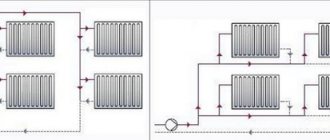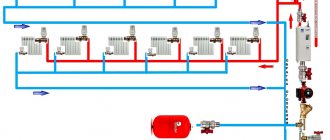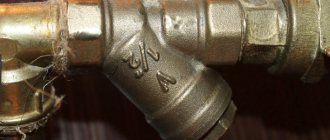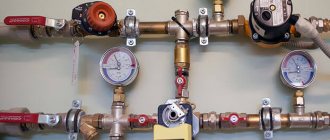Replacing radiators
Before replacing the heating system in the apartment, radiators are purchased; bimetallic batteries are considered the best among them today. Why? The fact is that the basis of devices intended for heating housing are collectors and vertically located channels made of steel grades resistant to corrosion processes, in contact with the coolant (more details: “The best heating radiators for an apartment: classification”). Experts warn: you should not give preference to cheaper bimetallic radiators - they only have steel cores on the vertical channels. Such products are similar in strength to aluminum batteries.
As for bimetallic radiators, their outer shell made of cast aluminum has developed fins. The combination of metals allows the production of heating devices with a high degree of heat transfer and excellent strength. As an example of the use of the latest technologies in heating systems, we can note the bimetallic radiators Monolit from the Rifar company; their appearance can be seen in the photo. For this series, the operating pressure is 100 atmospheres, the products can withstand a test load of 150 atmospheres. The fracture pressure value is 210.
Checking heating system elements
You need to remember about other elements of the system. After all, without their correct operation, it is impossible to properly start the heating system. First of all, you should check the normal functioning of the measuring instruments - thermometer pressure gauges.
The operation of protective components must also be monitored. Proper starting of the heating system may be prevented if the air vent or bleed valve seats are unable to move due to rust or limescale. To do this, you need to manually open each of them.
The pressure of the air chamber is controlled in the expansion tank. It should be 5-7% higher than the nominal value in the system. If the design of the tank provides for the possibility of replacing the membrane, you need to disassemble it and check its condition.
Currently, the service of starting a heating system is very rare. It is impossible to indicate even approximate prices - in most cases the price is determined on an individual basis. Its size directly depends on the current state of the system and its complexity.
In the video you can familiarize yourself with the technology of filling the heating system with coolant.
Heating water supply boiler room
LLC DESIGN PRESTIGE > https://resant.ru/
Telephone: 8(495)744-67-74
We provide installation services for heating and water supply systems for private country houses, dachas, and organizations. We supply equipment for work at discounts.
Our services:
Heating:
Installation, design, service repair. Heating by type: autonomous, water, private, wood, individual, gas, natural.
Basements
As a rule, initially basements in apartment buildings were planned as a place where all the nodes of heat and water communications were collected, ventilation also took place here, and the central sewage system of the building was located.
Currently, basements are often converted into cafes, gyms or shops. Heating the basement of an apartment building is part of a centralized system, which heating network technicians are required to look after. To prevent it from becoming a “black hole” in the budget of the house, it should be carefully insulated and this should be done, as in the entrance, by the heat supplier.
Residents of the building have the right to check how well the work has been done , since they are the ones who pay all the costs for heat, regardless of whether there is a common building meter or not.
Correct thread installation
So what you need to pay close attention to
- Using a file or turbine, it is necessary to remove the chamfer, after which an entry for the die will be made.
- The die with the holder on the long side is placed on the tube. This operation is necessary for a perpendicular entry of the die onto the pipe.
- Short threads are applied to the riser, not exceeding five threads. The thread is applied strictly clockwise.
- When the die approaches the edge of the tube, it is worth pressing the holder as powerfully as possible with all your might.
- After cutting the first thread, you need to hold the riser with a gas wrench. The maximum force is applied so that the rotational moment of the die can be compensated, since otherwise it will be possible to break the thread of the riser on the floor above or below.
- If a convector is mounted for welding, then there is no need to hold the structure, since it is impossible to tear out such a riser.
- It is necessary to cut a long thread on the connection to the radiator and on the outlet in the jumper.
- During the cutting process, a piece of tube must be fixed with a vice in order not to destroy the structure of the already cut thread.
Problem
The main problem that my relatives told me about was absolutely cold radiators in two adjacent rooms, while in other rooms the radiators became noticeably warmer with the start of the heating season.
- In rooms with warm radiators, the average daily temperature was +17C;
- In rooms with non-working heating +13C.
As they say, feel the difference...
For several days, calls from neighbors and relatives to the heating network ended in approximately the same way - nothing, because... the house is a cooperative one, and its maintenance is not their responsibility, except in emergency cases.
And for a cooperative of 60 apartments (4 entrances), where more than half of the residents are people of deep retirement age, it was expensive to maintain its permanent plumber out of pocket. The part-time specialist only made sure that there were no leaks during the startup of the system, and nothing more.
Searching of decisions
Having arrived at the place, the first thing I do is check the taps on the radiators and on the bypasses - everything is in the open position in both rooms. I open the Mayevsky taps on each radiator - a thin stream of water informs that there is pressure in the system and the radiator is not air-filled. But you need to find out whether there is any coolant in the system at all.
For this purpose I go to the basement of the house. From the elevator unit I determine the direction and find “my” supply and return pipes.
This is our highway.
Having reached the location of the apartments at our entrance, I see two pipes - supply and return. To the touch, both pipes differ quite noticeably, so it was not difficult to determine that the colder one was the return pipe.
In the foreground is the return line.
I use my hands again - both risers are cold, although literally a meter before this section the temperature was more than comfortable. The reason is the airing of the system on the upper fifth floor, which is why the coolant does not circulate.
I leave the basement and go to get acquainted with the neighbors on the upper floor, simultaneously inquiring from other residents about the presence of shut-off valves and their condition. As you would expect, they all have cast iron radiators installed 30 years ago.
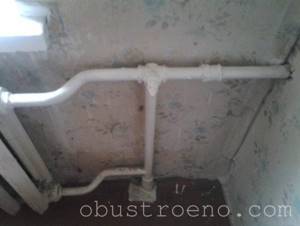
The fifth floor is a bridge between rooms.
In Khrushchev-era houses there is no technical floor, so the coolant is supplied from below from the basement. To clarify the operation of the heating system, I propose to consider the diagram presented below.
Red arrows show the direction of movement from the supply, blue arrows indicate the return direction.
We return to the fifth floor apartment. In two rooms of a family of pensioners, cast iron radiators with 12 and 7 sections were installed. They were the ones who had to be ventilated.
The reason for the lack of heat is the accumulated air inside the radiator.
The only way available for this is using a nipple (a prototype of the Mayevsky tap) embedded in the radiator plug.
Upcoming job.
- Old galvanized bucket 12 liters;
- Pliers;
- Two flat blade screwdrivers;
- Several floor rags - splashes will be inevitable.
Here it is our simple tool.

I install a bucket under the radiator.
Since a lot of splashes are expected, I provide a place to work around the radiator - I remove the flower pots and move the furniture further away. Then I take a screwdriver and, carefully, so as not to lick the edges, unscrew the screw counterclockwise.
The effort has to be excessive.
- The old system did not work on the first try, I had to use pliers - with their help I turned the screwdriver until the screw came off the stuck place;
- The hiss of air marked the beginning of the air lock coming out. Within 3-4 minutes, the air left the radiator, after which cold water flowed in a thin stream;
- Having adjusted the screw so that the water poured into the bucket, I gave it time - in about half an hour, when the bucket was half filled, the temperature of the water changed from ice to warm, after which I screwed the screw back.
Material selection
How justified is this choice of material?
- The installation itself is greatly simplified. It is performed without the use of welding in the shortest possible time.
- Pipes are easily bent by hand: you can make a contour or bend on the spot.
- Pipes and fittings are lightweight: lifting the necessary materials to the fifth floor will not take much effort.
It would seem that everything speaks in favor of modern materials. Not so.
Attention: if you want to create a minimum of problems for yourself in the future, use only and exclusively galvanized water and gas pipes for installing risers and supply lines to valves.
Why? After all, the normal operating mode of the heating system is within the parameters stated for the same polypropylene with a margin?
You see, the human factor has not been canceled. As soon as a mechanic forgets to close the inlet valves while testing the heating main for density, the pressure in the risers will be equal not to 4-5 atmospheres, but to 10-12.
It is enough to quickly open the house valves when starting the heating - and the result will be a water hammer, during which a short-term pressure surge of up to 15-20 kgf/cm2 is possible.
What about annual temperature tests? Remember those few days in the spring when the radiators are hot? Working in extreme mode reduces the resource of plastics, and very much.
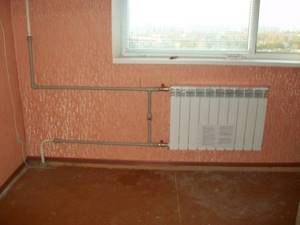
The photo shows a very dubious implementation of replacing a section of the riser. Placing plastic in a central heating system before the shut-off valves is not a good idea.
So, the choice is made. To replace heating risers we will need a galvanized pipe DU20; We will also provide connections to the heating devices. What is needed besides a few meters of pipe?
The answer depends on whether you have welding and the related skills at your disposal. Please note: you need to be able to weld sealed seams, and with a mirror.
By the way, gas welding in problematic conditions is somewhat easier to work with.
- If there is welding, you need welds - long and short threads to which radiators and shut-off valves will be attached. In addition, you will need three locknuts for each radiator; three drives - one each for the connections and the jumper; three DN20 valves.
The valves will be in different positions or will block the flow of water through the jumper, directing the entire volume of water to the heating device; or, conversely, limit the permeability of the battery when the jumper is completely open.
Useful: valves are only and exclusively modern ball valves. It is better to completely forget about the existence of screw valves. As an option, a throttle or thermal head can be installed on one of the connections.

Exceptionally reliable, comfortable and hassle-free design.
- When assembling by hand, you will have to arm yourself with a die with a holder and a turbine with a cutting wheel for steel. All straight pipe threads will be manufactured on site. In addition, you will need the entire set of parts listed above; two tees (cast iron or brass) and two couplings. The threads will, of course, have to be cut in a vice.
Heating system of an apartment building
Central heating systems for apartment buildings were created in accordance with the projects.
Therefore, you can literally learn everything about heating an apartment and the entire house if you find the project and understand it down to the last screw. Next, we will consider what heating solutions are usually used in apartment buildings, and how they affect the quality of heating in apartments. And also how issues related to the repair and operation of pipes, batteries and the entire centralized heating system of a high-rise apartment building are resolved in practice
Why are you interested in the heating scheme of a high-rise building?
The heating system of a multi-storey building can be of concern in several cases, for example:
- When replacing a radiator in an apartment, the question arises - how to turn off the riser, what kind of radiator can be installed and what is the best way...
- If you change the riser, what pipes can be used?
- When the heating is not working well, it is natural to ask why? - maybe you can adjust it, even on your own...
- If you want to organize your own boiler room together with other residents, then how to do it...
- When installing a heat meter, where in the system should it be installed?
But without the approval of the housing office, no action with centralized heating. And such actions are usually performed only by specialists of the same service organization.
What schemes are found in apartment buildings
Projects for heating entire areas from a central heating station are always individual and depend on the housing stock. Usually one boiler house was built per microdistrict, but this is not the rule; very large thermal power plants and small boiler houses were built.
But heating distribution in high-rise buildings built in Soviet times is, as a rule, standard. Single-pipe radiator connection schemes were used, where one pipe was a vertical riser. The risers, of which there were many per house, were connected in parallel to the heating supply main, and thus found themselves in approximately the same hydraulic conditions.
An approximate diagram of a vertical single-pipe is shown in the figure. Please note that there are up to 18 radiators on one pipe.

The correct radiator connection diagrams are using a parallel bypass.

Connection diagram for a radiator in an apartment with single-pipe wiring throughout the house.
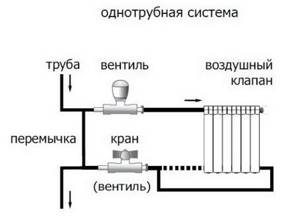
Disabling one radiator (drip!) will not affect heating in other apartments due to the presence of a bypass. In addition, the balancing valve allows you to dim the radiator at will.
But single-pipe systems have a known drawback - the last radiators in the ring are cooler. How did you deal with this?
Features of heating in apartment buildings
To prevent radiators on the top floors from being too cold, a high coolant flow rate must be set along the riser, which equalizes the supply and return temperatures. In centralized heating systems, they were able to make sure that the temperature in the riser was without a significant difference for users. And no one struggled with increasing the area of radiators to equalize heat transfer.
- A centralized heating system is characterized by high coolant flow rates, to the point where noise occurs in the pipes. Hence the high pump power and high pressure drop.
- The second feature is the high total pressure in the system. Filling was carried out from the bottom point, and in order to raise the coolant to the 9th floor it was necessary to create the appropriate pressure, up to 12 atm.
- The next feature is the high temperature of the coolant - poor thermal insulation, heat leaks, wastage of energy resources, which often allowed utility companies to solve the problems of “heat in homes” by simply increasing the flow rate and increasing the temperature above the norm, even above 100 degrees C at increased pressure.
All this places its own demands on radiators and pipes.
What pipes and radiators should be used in a multi-storey building?
All high-rise buildings in Soviet times were equipped with steel pipes and cast iron radiators. Now there is a choice. Other types of pipes and radiators are more practical, cheaper, and more durable.
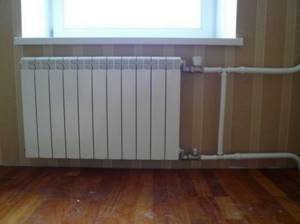
But making your own choice when replacing a radiator in an apartment without consulting the housing office is unacceptable. Moreover, dismantling the riser and changing pipes is something only specialists will do.
Basically, Zhekovsky specialists solder PN30 foam propylene 25 mm (outer diameter) with aluminum reinforcement, despite the fact that its maximum temperature is still +95 degrees, and in the central line it can be more... Now PN25 with similar characteristics have already appeared.

It is also possible to use metal-plastic pipes to connect radiators in a multi-storey building - according to the decision of the network maintenance service. The diameter used is generally 20 mm (outer).
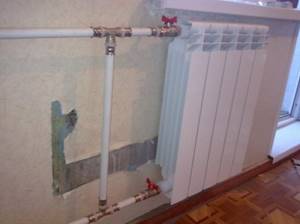
When replacing a radiator, the utility workers will definitely oblige you to create a circuit with a shutdown using two taps and a bypass parallel to the radiator.
When replacing a radiator in an apartment
- The model and dimensions (heat output) of the radiator are agreed with the specialists of the service organization.
- The riser is turned off and the liquid is drained.
- Usually old steel pipes are cut off, since it is not possible to unscrew the threaded connections. More often, radiators are replaced along with pipes; the types of pipes used are also agreed upon with the housing office.
- The radiator is hung on a standard mount and is equipped with plugs, ball valves, and a Mayevsky valve.
- The radiator is connected to the riser pipes using a bypass circuit.
Why is it cold on the upper floors?
If the coolant speed is reduced and the temperature is also reduced, then the houses will be cold, this will especially affect the upper floors, where the radiators are often the last in the ring. This happens both for technical reasons, due to overgrowing of pipes, wear and tear of equipment, and for organizational reasons.
Fuel is now expensive, and it is not known at what level of command, its allocated amount has been halved, but the result is impressive - half of the allotted coal, fuel oil, and gas ends up in the firebox. And the heating network specialists were asked to “get out” and redistribute the heat, “to find methods.” As a result, some of the pumps are turned off and replaced, the boiler is turned off, the valves are tightened, and artificial “wear and tear of the equipment” is created.
Another option for poor heating performance in a multi-storey building is that the radiators do not heat. In any basement of a multi-storey building, adjustment options are possible when any riser heats poorly - the scheme is very complex. The problem may lie in the lack of decent personnel in the organization, as a result of which the network is simply not established.

But a way out of the situation can only be found in the ordeal of local organizations. Or creating your own boiler room for a small house in agreement with the authorities. Or switching to individual heating in the apartment.
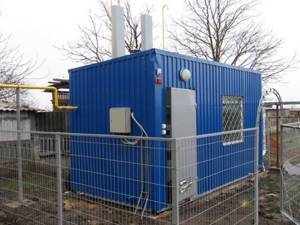
Features in new buildings
Currently, more and more people are switching to modern heating projects. Two pipes are used in the wiring, as a result of which energy losses during the movement of the coolant are reduced. Connection diagram for a radiator in an apartment with a two-pipe heating system.
Need for thread
Next, the holder from the die is placed on the pipe. It should be located perpendicular to the axes of the riser. The die must fit onto the pipe even after the latter has been previously cleaned of any existing paint. To remove the chamfer, use a file, grinder or other available means.
The pipe requiring threading is also lubricated with oil. This will avoid the appearance of scuffs on the material, and the die itself will go much faster and easier. In this case, it should be pressed against the end of the riser, after which the holder is rotated. This is how the first thread of the thread is cut. Next, the riser is secured with a gas wrench. There should be no rotation of the pipe transmitted from the ram. Otherwise, you cannot do without damage to your neighbors' components.
For thread cutting, 5 threads will be sufficient. This is due to the fact that it is used only for attaching fitting adapters to the pipe.
Determining where air locks form
An important part of removing air from the system is correctly identifying where the airlock is occurring. Depending on the location of the air, different methods of removing it are used.
In any type of heating system, air pockets can form in two places: in pipes and radiators. In pipes, an air lock usually forms in the outer risers, where the difference in supply and return pressure is minimal. In radiators, air accumulates in the upper corner located opposite the supply connection.
The first thing to start with is to make sure that all the valves on the risers and heating radiators are open.
If on the riser next to the heating radiator there is a jumper (bypass) connecting the supply and return, bypassing the radiator, then first check it. If it is hot and the radiator is cold, then there is an air lock in the radiator. If it is cold, it means that the entire riser is not working.
If there is no jumper, then compare the supply and return temperatures. If both pipes have the same temperature, then the problem may be in both the riser and the radiator. In this case, we first try to bleed air from the radiator. If the supply is warmer than the return, then there is an air lock in the radiator. Because of it, the entire riser does not work.
Features of placing risers in rooms
Heating communications are located near the outer wall of the room; in a corner room, the pipeline is placed in the corner to prevent dampness of the walls. The placement rules are as follows:
- With a single-pipe system, the optimal distance from the window is 15 cm. The length of the liner reaches 40 cm.
- If the distance to the heating device exceeds half a meter, then the pipes are laid with a slight slope towards the battery.
- If the distance between the floors does not exceed 3 meters, additional fastenings are not required. In a house with high ceilings, additional fastening is installed at the height of half the floor.
Actions if you don’t turn on the heating and it’s already cold
If the heating season has already begun, the first thing you need to do is make sure that all the batteries in the apartment are working properly. If only your home is cold, but your neighbors upstairs and downstairs are warm, the problem may be an air lock. Plumbers will quickly fix it.
The temperature in the apartment is important. According to SanPin standards, in a living room there should be at least +18 degrees, in a corner room +20 degrees. If the temperature in your home is lower, you need to call the emergency dispatch service and leave a request to solve the heating problem. Within one or two days, the cause of the malfunction must be found and eliminated, as well as notifying you about it.
You also need to demand that a representative of the management company come and record the fact that the batteries are not working and the temperature is low. The drawn up act will become the basis for recalculating the cost of heating and will serve as evidence that, if necessary, can be attached to the complaint.
How to shut off a heating riser
The heating riser belongs to common property. It must be blocked by employees of the service organization who have the right to do so.
If you follow the letter of the law, you must come to the DEZ, Housing Office, DEU, etc., write an application, pay for the service at the cash desk. At a certain time (indicate in the application) a representative of the service organization must come and turn off the valve in the basement.
How much does it cost to turn off the heating riser? This is not an easy question. The fact is that there are no fixed prices. There is a price list for services, but it is only a recommendation. In reality, each organization sets its own prices. On average, you will have to pay from $15 to $20 for this operation.
There is a workaround. Agree with neighbors and shut off the riser yourself without the campaign’s knowledge. But you know that this is not always possible: neighbors are different. If in the summer, when the heating is turned off, such actions may meet with understanding, then during the season - it is unlikely. There is another difficulty: the heating valve is not always easy to find. You either need to have a communication scheme, or just know where it is. They usually know a locksmith. But they won’t block the riser for free, and will require at least $10-15. There seem to be savings, but they are small. And if this fact becomes known to the management or operational company, you will face substantial fines.
Starting the riser
Upon completion of the work, all that remains is to put the riser into operation. First, the plug is screwed onto the winding. The entire system is filled with coolant. But even here there are some nuances that are worth paying attention to in the process of starting the heating system after replacing all components.
- There may be cases where there are screw valves, it is necessary to ensure that water flows in the direction in which the arrow on the body is directed. The consequence of non-compliance with this rule is that the valve comes off.
- Initially, one valve opens, wait a while until the coolant partially fills the system. This is done to create equal pressure, both in the riser and in the spill. When the sound of water disappears, all other valves in the system open completely.
Replacing the heating in an apartment with your own hands can be done during the heating season. Here, after completion of the work, air is first released on the upper floor. At the same time, you cannot even think about converting the heating system to an autonomous one on your own, since the culprit will face negative consequences, up to and including being deprived of the apartment.
The technology for carrying out installation work, its strict adherence to it, will answer the question of how to properly change the heating in an apartment. This is not particularly difficult, but basic knowledge will come in handy.
Wiring
A riser is a vertically installed pipe that combines several heating radiators into a single circuit. It is most often made of metal or polypropylene. The risers can be combined in pairs or be independent of each other.
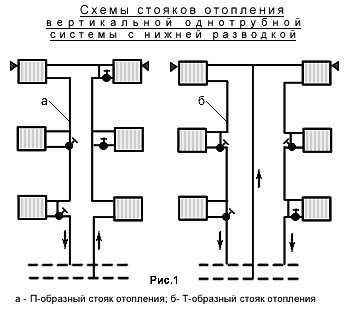
Heating risers with bottom wiring
Below we will consider both cases in more detail:
This happens because:
Advice: a lintel installed in the attic must be insulated. Otherwise, if in severe frost the movement of water in the pipelines stops for some reason, it will turn into ice. Then to restart you will have to use a blowtorch if the riser is metal.
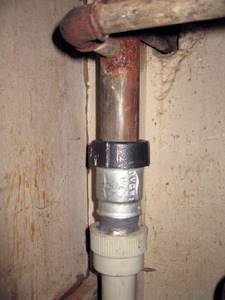
Connecting a steel pipe with a polypropylene pipe
Launch
After the heating riser has been repaired, it must be reset in order to start it up.
Let's figure out how to do everything correctly:
- Upper. Starting the heating is not difficult. The instructions are as follows:
- close the required riser in the attic and then in the basement;
- open reset;
Tip: in order not to make a mistake when turning off the heating in the attic, count the taps in the bottling, taking the nearest landmark for this, for example, the exit to the roof or the corner of the building.
- After completing the work, close the reset;
- slowly fill the riser, remembering the direction of movement of water in the valves;
- open both taps completely.
Flushing the system
We fill the heating system with water to a pressure of 2 bar, then turn on the circulation pump. If there is a system of primary-secondary rings or the boiler is connected directly to the system, then you can immediately start the boiler and without heating or with minimal heating we allow the system to work for about an hour.
After this, we check the condition of the mud filter. If it is clean, the washing is considered complete. If there is dirt in it, then you need to clean the mesh, start the system again, let it run for half an hour and again check the condition of the filter. The washing is considered complete; after half an hour there will be no dirt on the filter mesh.
The flushing water must be drained from the heating system, and the residues must be removed with a compressor. After this, you can begin filling the system with working coolant.
When is heat supplied to apartments?
Every citizen has a constitutional right to favorable living conditions, and the optimal temperature in the apartment is a component of comfort. Central heating ensures comfort in the house even in severe frosts. Housing and public utilities services, distribution centers or management companies are responsible for the quality of heating systems.
Cold radiators during the heating season are a direct violation of civil rights. To make a claim, you need to know exactly when the heating is turned on and understand some of the nuances of organizing heating of residential premises.
What law regulates the process of heating residential premises?
Relations in the field of heat supply to residential premises are regulated at the federal level by the following legislative acts:
- Federal Law “On Heat Supply” dated July 27, 2010 No. 190-FZ.
- Decree of the Government of the Russian Federation “On the provision of public services” No. 354 dated May 6, 2011.
- GOST 30494-2011 “Indoor microclimate parameters” dated 01/01/2013.
The above documents define the relationship between owners and utilities, the start and end dates of the heating season, as well as the rules for the provision and calculation of utilities.
Principles of district heating
A centralized water heating system is the most popular option for supplying heat to apartment buildings. Heat energy is supplied from thermal power plants via heating networks and intra-house communication systems.
Monitoring the maintenance of an optimal microclimate helps to implement the heating temperature schedule. It is compiled based on the following indicators:
- temperature in the water supply and outlet pipes in the heating system and the difference between them;
- temperature outside and inside the room.
The colder the air outside the window, the higher the temperature of the water in the battery should be. A heating schedule is needed to adjust equipment power when weather conditions change.
With its help, several problems are solved at once:
- energy consumption is optimized;
- the optimal temperature level in the room is maintained;
- citizens' costs for paying utility bills during the heating season are reduced.
The heating schedule must be attached to the service contract with housing and communal services or RSO.
Beginning of the heating season in Russian regions
The heating season is the period of time in which heat is supplied through a centralized heating system. Previously, six months were allotted for heating activities - from October 15 to April 15.
However, due to differences in weather conditions in different regions, it was decided to determine the date for turning on the heating system based on a combination of the following factors:
- average daily temperature;
- weather forecast for the near future.
If within five days the average daily temperature does not exceed +8 °C, the district administration adopts a resolution on the opening date of the heating season. The timing may be adjusted if warming is predicted.
Time range for turning on central heating systems by region:
| Region | Start date of the heating season |
| Nenets Autonomous Okrug, Omsk, Arkhangelsk, Murmansk regions | Beginning of September |
| Saint Petersburg | Mid September, early October |
| Moscow and Moscow region, Central Black Earth Region | Early October |
| Southern regions* | Mid-October, end of November |
* In the city of Sochi, only 3 months are allotted for the heating season. In this region, heating is turned on in mid-November, and turned off at the end of February, beginning of March.
Heat is supplied to objects in the following order:
- kindergartens, schools, hospitals and other buildings of social significance;
- administrative and industrial buildings;
- residential premises.
Interesting! In houses with autonomous heat transfer systems, the start and end dates of heating activities are set by the decision of the owners.
Features of the end of the central heating season
The heat supply is stopped if the average daily temperature is more than +8 °C for five days. However, due to the instability of weather conditions, management companies prefer to play it safe and are in no hurry to turn off the central heating, because restarting the system is a very labor-intensive undertaking.
The start and end dates of the heating season are determined by municipal, not utility services. The municipality sends an order to the CHP, which, in turn, notifies the housing and communal services and management services about the timing of turning on and off the heat supply.
The resolution on the heat supply schedule is published on the website of the district administration. If the heating is not turned on on the specified dates, this can serve as a precedent for a complaint.
FAQ
With the onset of the first frosts, residents of apartment buildings begin to think about when the heating will be turned on, and whether it is worth buying additional heating devices in order to maintain the optimal temperature in the off-season. What to do if the heating is turned on late, and who to contact when the radiators at home are barely warm.
Is it possible to turn off during the heating season?
Accidents on heating mains are not uncommon. Such force majeure, as a rule, entails the shutdown of hot water supply and heating. The legislation provides for standards for one-time shutdown of heating, which must be observed.
Standards for turning off heating during the season:
| Room temperature in °C | Shutdown time in hours |
| +12 | 16 |
| +10 to +12 | 8 |
| +8 to +10 | 4 |
Important! If the apartment owner proves that the temperature in the room does not meet the approved standards, he may demand financial compensation in the amount of 0.15% of the monthly heating fee for each hour of violation.
How to heat an apartment in the off-season
It may take a long time before the average daily temperature reaches the conditional level at which the management company is obliged to turn on the heating. In autumn, the sun does not warm up the walls much, and with the onset of darkness they quickly cool down, sucking the heat out of the room. You can heat the apartment while waiting for the central heating to start using additional equipment:
- oil radiator;
- fan heater;
- air heating unit.
Double-glazed windows or inexpensive, but quite effective, sealing of windows for the winter will allow you to retain heat.
What to do if there is no heat in the apartment
After the onset of winter cold, the temperature of living quarters should not fall below +18 °C.
If the heating system cannot provide the temperature regime specified by GOST, the owner must immediately notify the emergency dispatch service of the presence of violations.
Applications can be accepted by telephone or in person. In both cases, the dispatcher is required to provide his details and record the time the complaint was received.
Upon request, an examination is carried out. If the owner of the apartment has not determined his time for carrying it out, then the inspection is carried out within two hours after receipt of the application.
Based on the results of the inspection, a report is drawn up containing the following information:
- measurement methodology;
- tools and devices used;
- identified violations or the absence of such violations;
- date and time of the inspection.
If the results of the inspection by the management company do not satisfy the owner, he has the right to request a re-examination with the participation of members of the State Property Committee and the public association of consumers.
How to determine the average daily temperature
The average daily temperature is defined as the arithmetic mean of all measurements taken over 24 hours. To calculate it, you need to do the following:
- take air temperature measurements at intervals of 4 hours (the interval can be any);
- add all values;
- divide the resulting amount by the number of measurements.
The result will be the average temperature for the day.
Where to complain if batteries stay cold
In the event of a lack of heat, apartment owners can file a complaint with one of the organizations responsible for maintaining the building:
- management company;
- housing and communal services service or RSO;
- housing inspection.
If contacting local authorities does not bring the desired result, it is necessary to file a formal complaint with higher authorities:
- local administration;
- Rospotrebnadzor;
- the prosecutor's office;
- court.
Official requests can be left on the websites of the above organizations.


